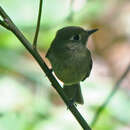zh-TW
在導航的名稱


The Pacific-slope flycatcher, or Empidonax difficilis, is a migratory bird in the Tyrannidae family. Its breeding range covers the humid coniferous forests of the Pacific Northwest and the Pacific coast from southeastern Alaska to Baja California in Mexico. Its yearly migration southward takes the flycatcher through southern Canada and the U.S. states of Washington, Oregon, California, Arizona, and New Mexico to the Pacific coast of Mexico, where it overwinters from northern Baja to a southern extreme of Oaxaca. Rarely does Empidonax difficilis overwinter as far north as California (Kaufmann 2017). It generally lives in wooded areas, and prefers warmth and humidity (All About Birds 2017).
The adult Empidonax difficilis has yellow-olive to olive coloration, with pale yellow lores and brown irises. Its underside is plain and yellowish. When molting, Empidonax difficilis changes relatively few feathers. The coloration of the wings creates two distinct bars, with lighter tips and a darker background. Males are generally more elongated than females, though they typically weigh slightly less. Empidonax difficilis diet consists primarily of insects and other arthropods with some vegetable matter, including blackberry, elderberry, and tarweed (Lowther et al 2016).
Empidonax difficilis is a solitary bird until mating season, during which it is fairly aggressive when on breeding grounds. It gives swift chase while also vocalizing a series of “chrrips” and “bzzt” notes, squeaks, and bill snaps. Near their nests, they have been observed being selectively territorially aggressive, but notably does not attack the California towhee, black-headed grosbeak, or western bluebird (Lowther 2016). They have also been noted to defend their territory against Hammond’s flycatchers (Kaufmann 2017).
Empidonax difficilis usually build their nests on or very near the ground. Nests are assembled entirely by the female and have been observed in the forks of trees, on stumps, within the upturned roots of fallen trees, under bridges, and on rafters in sheds (Lowther et al 2016). A clutch usually consists of 3 or 4 eggs, and are incubated for 13–16 days, during which the female stays in the nest for 75-80% of the incubation period. The nesting period is around 2 ½ weeks and once young leave the nest, they usually remain together for 7-8 days before becoming more dispersed. Empidonax difficilis first reproduce at approximately one year of age and annually thereafter.
Common predators of Empidonax difficilis are very likely similar to those of other small, woodland birds including owls, snakes, and hawks, as well as Steller’s jays and Western screech-owls, though little information exists on this (Lowther et al 2016). When alerted to predators, males give “seet” calls and females sit quietly on their nest (Kaufmann 2017). Though the species is declining in number due to multiple factors such as deforestation and climate change, Empidonax difficilis is classified as “least concern” by the IUCN due to its large population and vast range (Birdlife International 2017). In the state of Washington, however, the bird is listed on the “Audubon Washington Vulnerable Birds List” as “Early Warning” (Seattle Audubon 2017).